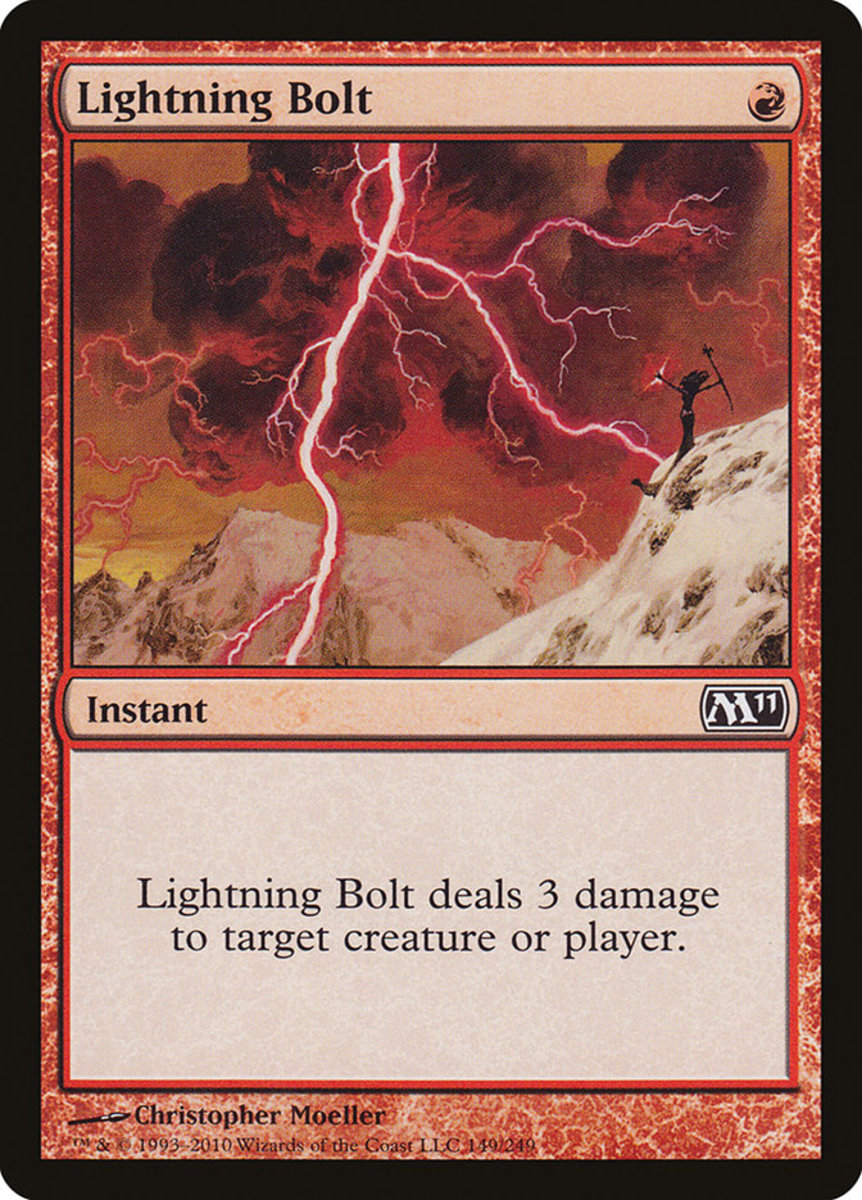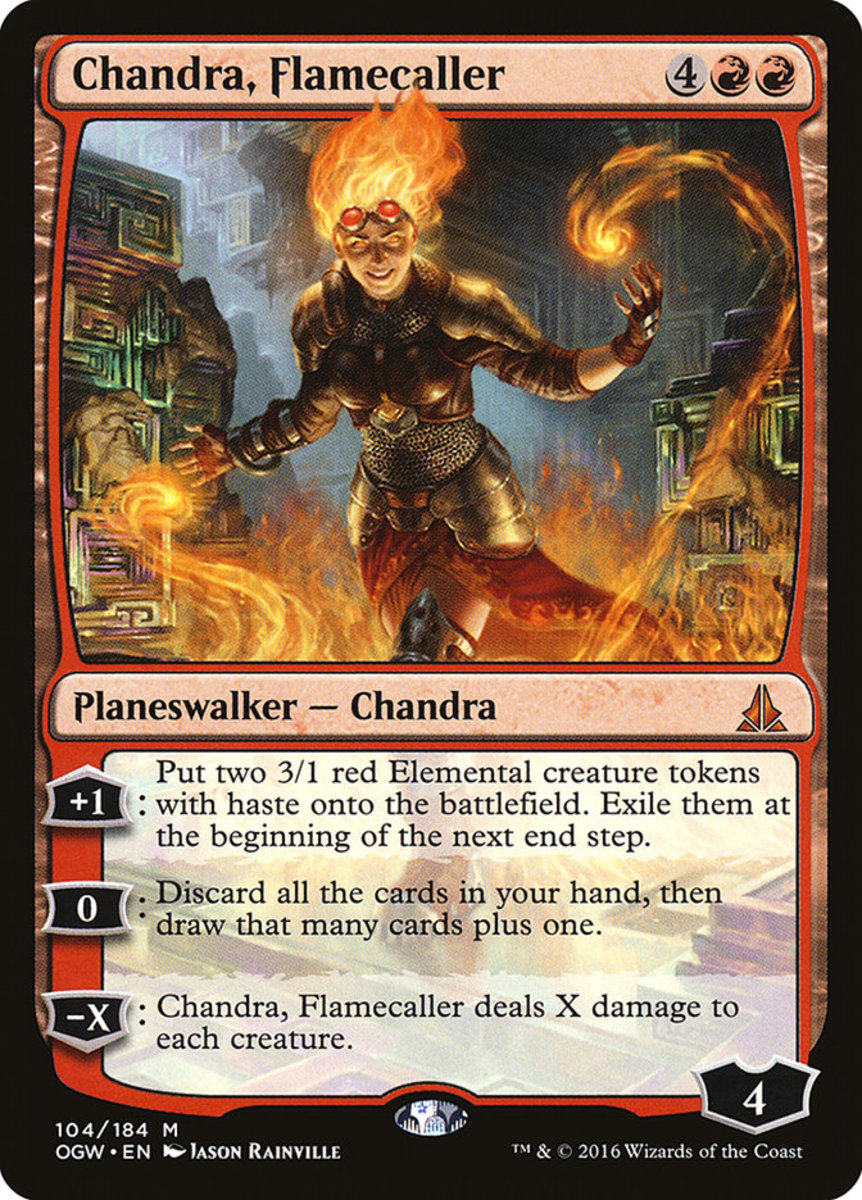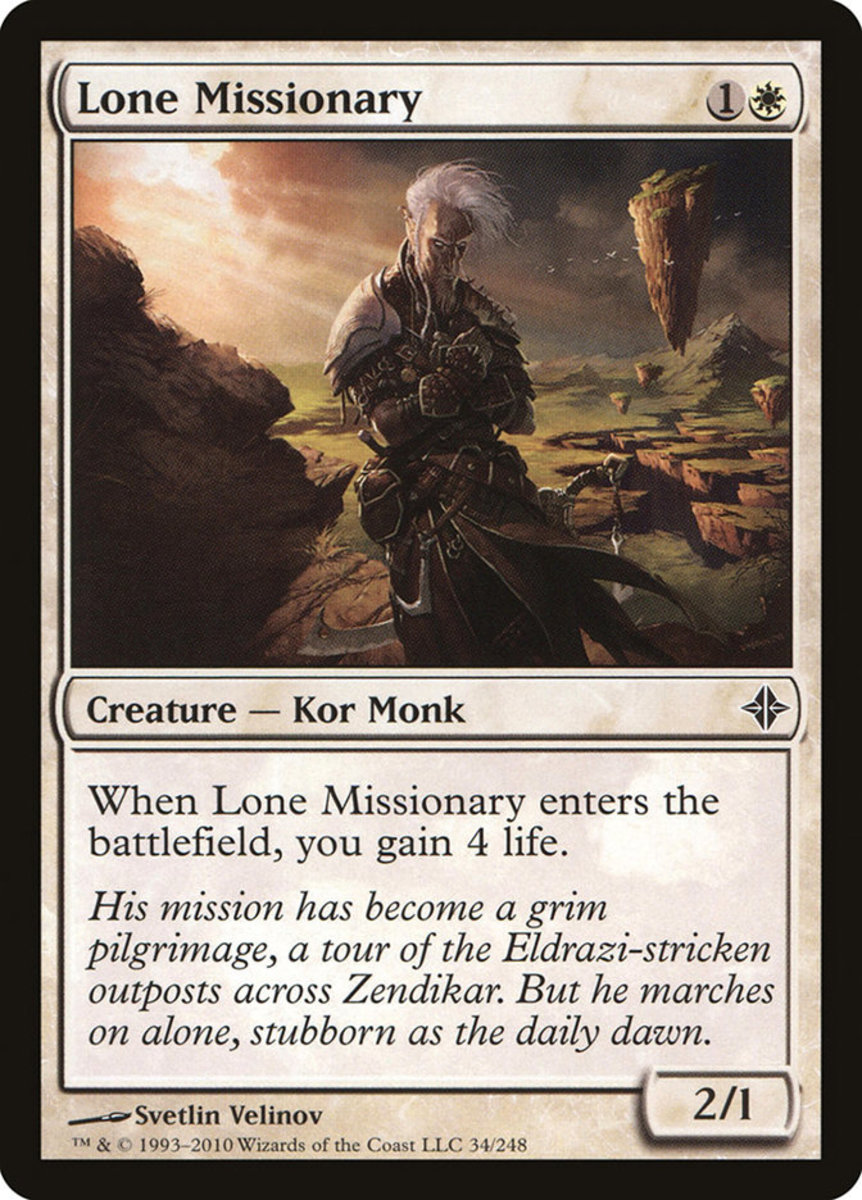- HubPages»
- Games, Toys, and Hobbies»
- Card Games»
- Collectible Card Games
Welcome to Magic the Gathering
Please read before getting started.
Before we jump into the actual rules and mechanics of the game I do want to remind all of you reading this that Magic the Gathering, above all else, is a GAME. It is meant to be fun! I suggest finding a friendly group of casual players to start playing with so you can learn as much as possible and still want to play the game afterwards (I can't tell you how often I've seen seasoned players show no pity while completely decimating someone new to the game and ruining his/her experience). It would be even better if you get involved into some multi-player games where you can relax and just watch how the game plays while still being involved. Reading the rules are important and going through little tutorials like this will also teach you a lot. That being said, Magic the Gathering is the type of game where participating will always teach you more than the rule book or any tutorial (still read the rules so you don't begin completely clueless). Always remember that the most important rule of all in this game is: read the card. I'm going to mention this in most of my articles (even the non-magic related ones). The card makes most of the rules so you must listen to it. If you don't understand the card don't be embarrassed to ask for an explanation it's part of the game (and if you are playing with people who make you feel terrible for asking a question then I suggest looking for some different players). Please enjoy the rest of the article :D
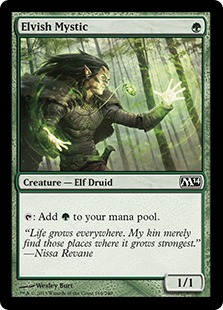
The Parts of a Card
In the top left corner of the card will be its title: this is an Elvish Mystic. In the top right corner of the card is the card's converted mana cost, also known as its casting cost. The casting cost can involve any of the five colors (including hybrids which can be cast for either) and/or a colorless circle with a number in the circle (the number can be paid by using any color mana). The large rectangular part in the middle of the card that seems to be a picture is a picture. Under the Picture to the left is where you will find the type of the card. Elvish mystic is a creature and in further detail it is an Elf Druid. To the right of that is the symbol that tells you which set the card is from. Under that line is the text box which will tell you what the card does and some cards will involve what is called a flavor text (an entertaining sentence or two which involve the story). Some cards don't even have abilities (they are known as vanilla cards). Elvish Mystic has an ability where he will add an additional forest mana to your mana pool. In the bottom right corner of the card is where the creatures power and toughness will be. The number on the left is the power and the number on the right is the toughness.
Example of a Planeswalker
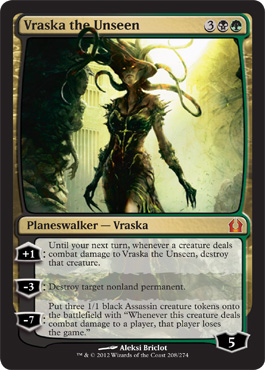
The Seven Card Types (a brief overview)
Magic the Gathering has seven types of cards that participate in the game: Land, Creature, Artifact, Enchantment, Sorcery, Instant, and Planeswalker. Every card is going to be clearly labeled as one of these types. These seven types are divided into two sub-types: permanent and non-permanent. When a card is a permanent it means that, after successfully playing the card, the card will remain relevant and on the field (these are your lands, creatures, artifacts, enchantments, and planeswalkers) . Non-permanents do not remain on the field after being successfully cast (instants and sorceries) .
The most important of all the types are going to be your land cards. The land cards are your power source for the entire game, without the land cards you would not even be able to play the game. Creatures will be your soldiers in your campaign towards victory. Artifacts and enchantments are very similar in the way that they are both permanents, both can affect: players, creatures, lands, other artifacts and enchantments, and even the entire game. The only really discernible quality is that they are two separate types so they can not be affected by all the same spells (making the game last longer). Artifacts also can come as equipment cards which will have an additional cost to interact with a specific creature. All of these permanents can be more than one of the types and form hybrids (such as: artifact creatures, enchantment creatures, artifact enchantments, etc.).
A sorcery card will affect whatever it affects for only the turn it was played and can only be played during your turn (during one of your main phases). An instant does exactly what a sorcery does but can be played during any time (during any phase, on anyone's turn).
The planeswalker is the newest of these types and has picked up an incredible amount of popularity so you will definitely see these during play. A planeswalker is a type of permanent that survives off of something called loyalty counters and will enter with a certain amount of these loyalty counters. The average planeswalker will have three abilities that will either add or subtract loyalty counters. All of these abilities will have their own actions (drawing cards, playing additional lands, giving you creatures, etc.). And when the planeswalker loses all of it's loyalty counters than it leaves the field. A planeswalker can be attacked directly just like a player or can be dealt damaged or destroyed just like a creature can.
I know it is a lot of information to take in at one time (and there is about to be more), but everyone of these card types can be played turn one and you need to know what you are dealing with.
The Six Steps of Gameplay
The game begins with the players deciding who will go first. This is usually decided by rolling dice and whoever gets the highest roll wins and decides who will go first (whoever goes first in a two-player game isn't given the opportunity to draw a card but is in more control of the first few turns of the game). In multi-player games it is common for whoever gets the highest roll to go first and then continue clockwise (everyone draws first turn in multi-player games).
After turn order is decided everyone will draw their initial seven cards and decide whether to keep them or not (keeping low cost cards and at least two or three lands would be your best bet). If you aren't satisfied with your hand you do what's called a mulligan until you are satisfied. A mulligan is when you discard your entire your hand and shuffle it back into your deck and draw one less than you discarded (discard seven and you draw six. discard five and you draw four.) Everyone starts at twenty life.
The steps of gameplay are: 1. Upkeep -> 2. Draw Phase -> 3. First Main Phase -> 4. Combat Phase -> 5. Second Main Phase -> 6. End Step
The first part of a turn is called the upkeep. The upkeep is just the name given to the step before drawing. The only significance it has is that certain cards will have abilities that activate during this step.
After that is the draw step where you just draw a card from your deck.
The main phases are where most of the action will take place. This is where most of your lands, creatures, sorceries, planeswalkers, artifacts, and enchantments will be played. To begin the game you must play a land card first, let's say a Forest. After you have land, if you have enough to play a spell you are welcome to, like an Elvish Mystic. Elvish Mystic costs one forest to play, has a power and toughness of one each, and has the ability to add another forest mana to your mana pool. So you will tap (turn from vertical to horizontal) the forest and play the Elvish Mystic. Your mana will empty at the end of every step so be careful when you tap your land. After that since you do not have any more options your first Main Phase has ended.
Now it's the Combat Phase. Combat is where your soldiers and your opponents soldiers will clash in battle to both defend your life total and lower your opponents. Most creatures can not attack the turn they've been played they have something called summoning sickness (Creatures that have an ability known as haste and can attack the turn they've been played). When you attack you are attacking your opponent directly as opposed to your opponent's creatures (you can also attack your opponent's planeswalkers directly instead of your opponent). The point of attacking is to lower your opponents life to zero or lower and have them lose the game. Now you aren't forced to attack and in some situations it will be wiser to keep a defensive line so you don't lose the game. The combat phase will have three sub-phases: the declaration of attackers, the declaration of blockers, and the damage step. After attackers are declared they can not be changed. After Attackers are declared it is the defending players' turn to declare blockers. Blocking creatures can block only one viable creature (some creatures are unblockable or out of reach for certain creatures) at a time and more than one blocker can be assigned to one attacker. Once all blockers are declared it is the damage step and now all damage that is going to be done is going through. So if a creature does 1 damage to my 20 life than I am now at 19 life. The easiest way to remember how combat damage interacts between creatures is that opposite numbers are the ones that affect each other. For example: if one elvish mystic is blocked by another elvish mystic than it will be 1/1 against 1/1 and they both will destroy each other. All damage that is done stays permanent until the next players turn.
After the combat phase is the second main phase where everything that can happen in the first main phase can also happen here.
The final phase is the End Step which just signifies the end of the turn and also works the same way the upkeep step works.
Instants can be played at any time during anyone's turn.
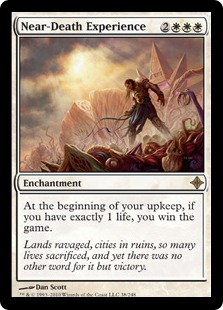
Winning and Losing the Game
In Magic the Gathering there are several ways to win and lose the game. The most often way the game will end is when there is only one player left with any life. Another way to make a player lose is known as milling. Milling is the act of making your oppenents' deck of cards lower until they reach zero. When you have no cards in your deck and you go to draw your next card you immediately lose the game. The final way to win or lose the game would simply be because a card says so (to win by pulling this off is actually a lot harder and more complicated than it sounds).
There is a bit more complicated way to win the game known as going Infinite. An infinite play is a combination of cards that interact in a way that automatically wins the game, like the example of Exquisite Blood and Sanguine Bond (shown below), or entering a filibuster. A filibuster is when someone will sit there and continue talking about how the infinite works until their opponents just give up out of sheer boredom. Filibustering in actual competitions might be stopped depending on the judges.
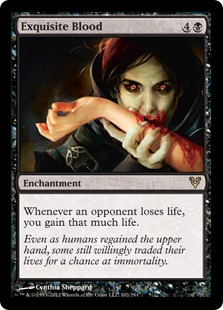
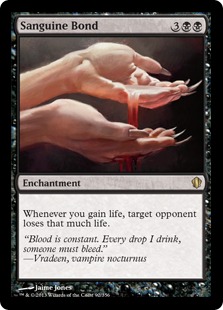
How the Infinite Works
This is the example of how an infinite will work. Let's say you have both Exquisite Blood and Sanguine Bond on the field. Your life is at 13 and your opponent's life is at 15. You cast the card Bump in the Night, which causes 3 damage to your opponent, and it goes through successfully. So your opponent goes down to 12, because your opponent lost 3 life that means you gain 3 life, and you go to 16. Because you gained the 3 life that means your opponent loses another three life which means the life is now; your life: 16 and their life: 9. This continues until your opponent is left with zero life.
This also applies in multi-player games because Sanguine Bond states target opponent. Even better in multi-player games you don't even have to cause the damage yourself because Exquisite Blood applies to all opponents. Unfortunately, this means you are going to become a major target by everyone because most people will not want you to end the game for everyone in one shot.
Now this doesn't all happen in one shot. It isn't an automatic win because of how the step system works. At any time someone can play an instant and alter how this would all take effect.
Starting to Play
The point of this article wasn't to teach you the entire game or prepare you for what you might face (I couldn't do that properly even with a 600 page book and freedom to use as many curse words as I want). It was to help you identify what is happening, both around you and to you, so you aren't going in to the game completely clueless.
When you first start I suggest either using someone else's deck, and having them help you through it to get a better understanding of it, or getting one of the starter decks which are sold in like Target or pretty much every card shop in existence. Building a deck yourself before understanding the basics of the game will probably end in disappointment.
I'm going to be posting more articles after this like: Building Your Own Deck, Explaining the Abilities, and The Different Play Styles of Magic the Gathering (which will include a more in depth approach of the five colors and the strategies available to you).

